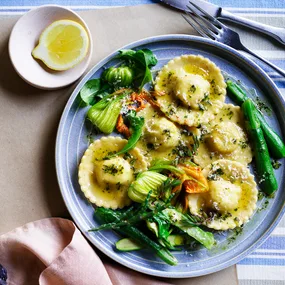Instead of the beef short rib, you could use 1.5kg beef oyster blade, cut into two pieces across the width. The oyster blade will cook more quickly than the short-rib (it takes about 1½ hours) and will be very tender and juicy. Begin this recipe a day or two ahead to make the bouillon.
The French think of pot au feu as their national soup but it offers so much more than a hearty bowl of broth. Its origin is from farming and peasant folk, who would keep a pot on the go year round, adding meat trimmings and vegetables to enrich this staple dish. Only richer folk could afford to add a piece of beef for Sunday lunch.
There are innumerable regional variations, but most are based on beef or very often just chicken, depending on the availability of produce. Some include bacon and root vegetables while others use lamb; there’s even one calling for a pig’s head as well as tripe sausages. Pot au feu has other titles such as potée, garbure, poule au pot and hochepot, and traditionally the soup is presented in its cooking pot while the meats and vegetables are served on platters and garnished with horseradish, cornichons, salt and mustard. It’s a complete meal, so just serve a light entrée or vegetable dish before it and follow it with perhaps cheese or a light dessert such as floating islands.
The initial preparation of a pot au feu requires some care to produce a clean-tasting bouillon. You need to soak the oxtail in cold water for several hours or overnight to release the blood, then drain it and place it in a clean sink with the veal shank and chicken giblets, washing the meat several times under cold running water. The next step is blanching to remove as much scum and fat as possible before cooking. It takes a little time, but the clarity of the bouillon is your reward. Keep skimming the stock until it looks pretty clear, maintaining a gentle simmer; not static but a continual slow movement, which will draw out the impurities. I try to do this while I’m cooking another meal or doing something else that keeps me in the kitchen.
You’ll have oxtail left over from making the broth; I like to use it to make a rich pasta sauce or a brawn. As soon as the oxtail sections have cooled, pull off the flesh and discard the discs and surplus fat. For a pasta sauce, combine the meat with a fresh tomato sauce and lots of parsley, three cloves of chopped garlic and the finely grated rind of two lemons, then toss it with spiral pasta and parmesan. For brawn, add six leaves of softened gold-strength gelatine to 300ml warm well-seasoned bouillon and stir until the mixture is cooled. Add the oxtail and parsley, garlic and zest as for the pasta sauce, then place it in a bowl for six hours to set. Serve it with mayonnaise and a salad.
Should there be any leftover bouillon it will freeze well to use as a base for soups, sauces or other braised meat dishes. Care should be taken to strain the hot stock and encourage it to cool quickly to avoid spoilage. This is best done by placing the bouillon over a bowl of ice mixed with a handful of salt and iced water. Stir the bouillon as frequently as practicable until it’s well cooled, then refrigerate it. Remove the fat once it has congealed and freeze the stock in containers.
It’s best to make the stock the day before for a clean-tasting broth. On the day of serving, a grand pot au feu needs up to five hours’ cooking to tenderise the tougher cuts of beef and veal shank while chicken and vegetables may be added later. I generally use beef short-rib, beef bone marrow, chicken and veal or pork fillet, thus reducing the cooking time without compromising the flavour.
The one non-traditional garnish I really enjoy is a beautiful mayonnaise flavoured with horseradish. I add drained pure horseradish to a thick homemade mayonnaise, then lighten it with a little whipped crème fraîche – and wow, does it enrich the broth.
Ingredients
Method
Main
Note To make a bouquet garni, tie 8 parsley stalks, 5 thyme sprigs, 2 fresh bay leaves, 4 strips lemon rind, 4 cloves of bruised garlic and 1 teaspoon cracked black peppercorns and 4 cloves in a piece of muslin. Ask your butcher to cut the veal shank into pieces for you.
Notes










